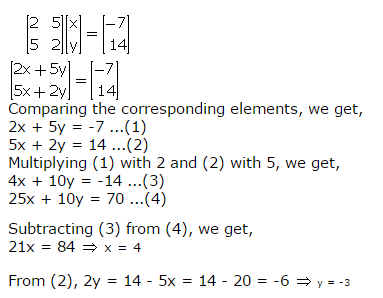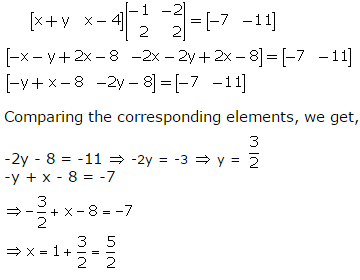Class 10 SELINA Solutions Maths Chapter 9 - Matrices
Matrices Exercise Ex. 9(A)
Solution 1(a)
Correct option: (i) x = 2, y = 1, a = 5 and b = 10
![]()
x + 2 = 4 ⇒ x = 4 – 2 = 2
y + 3 = 4 ⇒ y = 4 – 3 = 1
a – 2 = = 3 ⇒ a = 2 + 3 = 5
b – 3 = 7 ⇒ b = 3 + 7 = 10
Solution 1(b)
Correct option: (ii) ![]()
![]() and
and ![]()

Solution 1(c)
Correct option: (iii) ![]()

Solution 1(d)
Correct option: (iv) ![]()
A + P = B
Then, P = B – A

Solution 1(e)
Correct option: (i) ![]()
![]()
Additive inverse of (A + B) = ![]()
Solution 2
(i) False
The sum A + B is possible when the order of both the matrices A and B are same.
(ii) True
(iii) False
Transpose of a 2 ![]() 1 matrix is a 1
1 matrix is a 1 ![]() 2 matrix.
2 matrix.
(iv) True
(v) False
A column matrix has only one column and many rows.
Solution 3
If two matrices are equal, then their corresponding elements are also equal.
(i)
a + 5 = 2 ![]() a = -3
a = -3
-4 = b + 4 ![]() b = -8
b = -8
2 = c - 1 ![]() c = 3
c = 3
(ii) a= 3
a - b = -1
![]() b = a + 1 = 4
b = a + 1 = 4
b + c = 2
![]() c = 2 - b = 2 - 4 = -2
c = 2 - b = 2 - 4 = -2
Solution 4
(i) ![]()
(ii) ![]()
(iii) Addition is not possible, because both matrices are not of same order.
Solution 5
(i)

Equating the corresponding elements, we get,
3 - x = 7 and y + 2 = 2
Thus, we get, x = - 4 and y = 0.
(ii)

Equating the corresponding elements, we get,
-8 + y = -3 and x - 2 =2
Thus, we get, x = 4 and y = 5.
Solution 6
M =![]()
Mt = ![]()
(i) ![]()
(ii) ![]()
Solution 7
(i) X + B = C - A

(ii) A - X = B + C

Solution 8
(i) A + X = B
X = B - A
![]()
(ii) A - X = B
X = A - B
![]()
(iii) X - B = A
X = A + B
![]()
Matrices Exercise Ex. 9(B)
Solution 1(a)
Correct option: (ii) x = 3 and y = 2
4[5 x] – 5[y –2] = [10 22]
[20 4x] – [5y –10] = [10 22]
[20 – 5y 4x + 10] = [10 22]
20 – 5y = 10 ⇒ 5y = 10 ⇒ y = 2
4x + 10 = 22 ⇒ 4x = 12 ⇒ x = 3
Solution 1(b)
Correct option: (iv) ![]()

Solution 1(c)
Correct option: (iv) ![]()

Solution 1(d)
Correct option: (ii) x = –8, y = 5 and z = 9
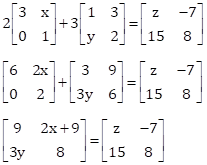
2x + 9 = –7 ⇒ 2x = –16 ⇒ x = –8
3y = 15 ⇒ y = 5
z = 9
Solution 1(e)
Correct option: (iii) ![]()

Solution 2

Comparing the corresponding elements, we get,
12 + 2y = 10 and 3x - 6 = 0
Simplifying, we get, y = -1 and x = 2.

Comparing corresponding the elements, we get,
-x + 8 = 7 and 2x - 4y = -8
Simplifying, we get,
x = 1 and y = ![]() = 2.5
= 2.5
Solution 3
(i) 2A - 3B + C

(ii) A + 2C - B

Solution 4

Solution 5
(i)
![]()
(ii)
C + B = ![]()
C
= ![]() - B =
- B = ![]()
Solution 6

Comparing the corresponding elements, we get,
2x
+ 9 = -7 ![]() 2x = -16
2x = -16 ![]() x = -8
x = -8
3y
= 15 ![]() y = 5
y = 5
z = 9
Solution 7

(i) 2A + 3At

(ii) 2At - 3A

(iii)
![]()

(iv)
![]()

Solution 8
(i) X + 2A = B
X = B - 2A

(ii) 3X + B + 2A = O
3X = -2A - B

(iii) 3A - 2X = X - 2B
3A + 2B = X + 2X
3X = 3A + 2B

Solution 9
5M + 3I = ![]()

Matrices Exercise Ex. 9(C)
Solution 1(a)
Correct option: (ii) m = 5 and n = 2
![]()
Then, m = 5 and n = 2
Solution 1(b)
Correct option: (iv) 36


Solution 1(c)
Correct option: (ii) 5 × 5
C5×5 × A5×5 + B5×5 × B5×5
= (CA)5×5 + (B2)5×5
Hence, the resulting matrix is of order 5 × 5.
Solution 1(d)
Correct option: (iii) BA
Since the number of columns in B is not equal to the number of rows in A, BA is not possible.
Solution 1(e)
Correct option: (i) ![]()
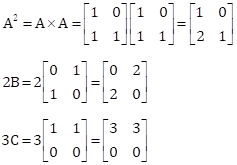
A2 + 2B – 3C
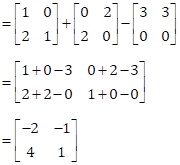
Solution 2

The number of columns in the first matrix is not equal to the number of rows in the second matrix. Thus, the product is not possible.
Solution 3

Solution 4

Solution 5
Solution 6

Hence, A(BC) = (AB)C.
Solution 7

Solution 8


Hence, M2 = 2M + 3I.
Solution 9

Given, BA = M2
![]()
Comparing the corresponding elements, we get,
a = 2 and -2b = -2 ![]() b = 1
b = 1
Solution 10
B2 = B + ![]() A
A
![]() A = B2 - B
A = B2 - B
A = 2(B2 - B)

Solution 11

It is given that A2 = I.
![]()
Comparing the corresponding elements, we get,
1 + a = 1
Therefore, a = 0
-1 + b = 0
Therfore, b = 1
Solution 12(i)
Solution 12(ii)
Solution 12(iii)

Solution 13
We know, the product of two matrices is defined only when the number of columns of first matrix is equal to the number of rows of the second matrix.
(i) Let the order of matrix M be a x b.
![]()
Clearly, the order of matrix M is 1 x 2.

Comparing the corresponding elements, we get,
a = 1 and a + 2b = 2 ![]() 2b = 2 - 1 = 1
2b = 2 - 1 = 1 ![]() b =
b = ![]()
![]()
(ii) Let the order of matrix M be a x b.
![]()
Clearly, the order of matrix M is 2 x 1.

Comparing the corresponding elements, we get,
a + 4b = 13 ....(1)
2a + b = 5 ....(2)
Multiplying (2) by 4, we get,
8a + 4b = 20 ....(3)
Subtracting (1) from (3), we get,
7a = 7 ![]() a = 1
a = 1
From (2), we get,
b = 5 - 2a = 5 - 2 = 3
![]()
Solution 14

Solution 15
AB = BA = B
We know that I × B = B × I = B, where I is the identity matrix.
Hence, A is an identity matrix.
Solution 16

Comparing the corresponding elements, we get,
3a = 3 + a
![]() 2a = 3
2a = 3
![]() a =
a = ![]()
3b = b ![]() b = 0
b = 0
4c = 4 + c ![]() 3c = 4
3c = 4 ![]() c =
c = ![]()
Solution 17

Clearly, the order of matrix X is 2 x 1.

Comparing the two matrices, we get,
2x + y = 3 … (1)
x + 3y = -11 … (2)
Multiplying (1) with 3, we get,
6x + 3y = 9 … (3)
Subtracting (2) from (3), we get,
5x = 20
x = 4
From (1), we have:
y = 3 - 2x = 3 - 8 = -5
![]()
Solution 18

Hence, proved.
Solution 19

Comparing the corresponding elements, we get,
2x + 12 = 0
thus, x = -6
6 + 6y = 0
thus, y = -1
Solution 20

Solution 21
(i) True.
Addition of matrices is commutative.
(ii) False.
Subtraction of matrices is not commutative.
(iii) True.
Multiplication of matrices is associative.
(iv) True.
Multiplication of matrices is distributive over addition.
(v) True.
Multiplication of matrices is distributive over subtraction.
(vi) True.
Multiplication of matrices is distributive over subtraction.
(vii) False.
Laws of algebra for factorization and expansion are not applicable to matrices.
(viii) False.
Laws of algebra for factorization and expansion are not applicable to matrices.
Matrices Exercise TEST YOURSELF
Solution 1(a)
Correct option: (iii) AB
Two matrices can be added or subtracted together if they are of the same order.
Hence, (A + B) and (A – B) is not possible.
Two matrices A and B can be multiplied together only if the number of columns in A is equal to the number of rows in B.
Hence, AB is possible.
Solution 1(b)
Correct option: (iii) 1 × 2
![]()
Then, a = 1 and b = 2
Hence, the order of matrix M is 1 × 2.
Solution 1(c)
Correct option: (iv) x = 6 and y = 3
![]()
2x – y = 9 ….(i)
x + y = 9 ….(ii)
Adding (i) and (ii),
3x = 18 ⇒ x = 6
6 + y = 9 ⇒ y = 3
Solution 1(d)
Correct option: (iii) 
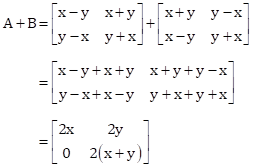
Solution 1(e)
Correct option: (iv) AB and BA
AC is not possible as the number of columns in A is not equal to the number of rows in C.
Hence, option (i) is incorrect.
The order of AB is 3 × 3, which is a square matrix.
But, the order of BC is 5 × 3, which is not a square matrix.
Hence, option (ii) is incorrect.
The order of BA is 5 × 5, which is a square matrix.
But, the order of BC is 5 × 3, which is not a square matrix.
Hence, option (iii) is incorrect.
The order of AB is 3 × 3, which is a square matrix.
And, the order of BA is 5 × 5, which is also a square matrix.
Hence, option (iv) is correct.
Solution 2

Comparing the corresponding elements, we get,
6x - 10 = 8
![]() 6x = 18
6x = 18
![]() x = 3
x = 3
-2x + 14 = 4y
![]() 4y = -6+ 14 = 8
4y = -6+ 14 = 8
![]() y = 2
y = 2
Solution 3

Comparing the corresponding elements, we get,
3x + 18 = 15
![]() 3x = -3
3x = -3
![]() x = -1
x = -1
12x + 77 = 10y
![]() 10y = -12 + 77 = 65
10y = -12 + 77 = 65
![]() y = 6.5
y = 6.5
Solution 4

(i) x, y Î W (whole numbers)
It can be observed that the above two equations are satisfied when x = 3 and y = 4.
(ii) x, y Î Z (integers)
It can be observed that the above two equations are satisfied when x = ![]() 3 and y =
3 and y = ![]() 4.
4.
Solution 5

Solution 6
Let the order of matrix M be a x b.
3A x M = 2B
![]()
Clearly, the order of matrix M is 2 x 1.

Comparing the corresponding elements, we get,
-3y = -10
![]() y =
y = ![]()
12x - 9y = 12

Solution 7

Comparing the corresponding elements, we get,
5x = 5![]() x = 1
x = 1
6y = 12![]() y = 2
y = 2
Solution 8

Solution 9

Solution 10
A = ![]()
A2 = A ![]() A =
A = ![]()
= ![]()
AB = A ![]() B =
B = ![]()
=![]()
= ![]()
B2 = B x B = ![]()
= ![]()
= ![]()
![]() A2 + AB + B2 =
A2 + AB + B2 = ![]()
= ![]()
Solution 11

Comparing the corresponding elements, we get,
3a - 8 = 24 ![]() 3a = 32
3a = 32 ![]() a =
a = ![]()
24 - 2b = 0 ![]() 2b = 24
2b = 24 ![]() b = 12
b = 12
11 = 6c ![]() c =
c = ![]()
Solution 12
A = ![]()
BA = ![]()
C2 = ![]()
BA = C2 ![]()
![]() =
=![]()
By comparing,
-2q = -8 ![]() q = 4
q = 4
And p = 8
Solution 13


= ![]()
= ![]()
Solution 14
A2 = 9A + MI
⇒ A2 - 9A = mI ….(1)
Now, A2 = AA

Substituting A2 in (1), we have
A2 - 9A = mI

Solution 15
![]()
(i) Let the order of matrix X = m × n
Order of matrix A = 2 × 2
Order of matrix B = 2 × 1
Now, AX = B

∴ m = 2 and n = 1
Thus, order of matrix X = m × n = 2 × 1

Multiplying (1) by 2, we get
4x + 2y = 8 ….(3)
Subtracting (2) from (3), we get
3x = 3
⇒ x = 1
Substituting the value of x in (1), we get
2(1) + y = 4
⇒ 2 + y = 4
⇒ y = 2
![]()

